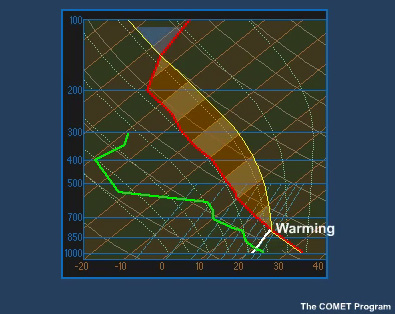Convective Inhibition (CIN)

Until now, we have ignored the common occurrence of a capping inversion, the strength of which is measured by Convective Inhibition (CIN). This lid can prevent near-surface parcels from reaching their level of free convection. As a result, this lid can prevent storms from forming, even with high instability aloft. In the presence of a capping inversion, some additional mechanism is required to initiate convection. In the absence of mesoscale lifting, there are three common mechanisms for overcoming a capping inversion:
- Heating (shown here)
- Moistening
- Synoptic-scale lifting
In the case of heating, the presence of a lid can prevent convection while the surface temperature climbs. As this figure shows, the instability, measured by CAPE, continues to grow until daytime heating eliminates the capping inversion. The ensuing convection can be much stronger than if it had occurred earlier, before significant heating had occurred. For example, an analysis of data from the central U.S. determined that the stronger the lid, the less likely convection was. However, if storms did form, they were more likely to be severe if the CIN was high.